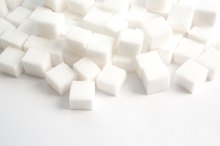Advantages & Disadvantages of Sugar
Although most people think of sugar as simply a sweet treat that should be consumed in small portions, many of the foods you eat consist of sugar molecules. Carbohydrates, one nutrient the body needs in large amounts, consist of sugar molecules. Each different type of sugar molecule affects the body in different ways. This complexity of sugar explains why it provides both nutritional advantages and disadvantages.
类型的糖
碳水化合物分为3个e different groups: simple sugars, starches and fiber. Sugar is the basic building block of all these carbohydrates. Simple sugars include both the single sugars, known as monosaccharides, and the double sugars, known as disaccharides. The single sugars -- glucose, galactose and fructose -- contain only one type of sugar molecule. The double sugars contain two types of single sugars combined together, such as lactose – the milk sugar – which consists of glucose and galactose. Starches and fiber, such as cellulose, are polysaccharides because they contain three or more sugars.
- 碳水化合物分为3个e different groups: simple sugars, starches and fiber.
- Starches and fiber, such as cellulose, are polysaccharides because they contain three or more sugars.
Energy
The Toxicity of Plug-In Air Fresheners
Learn More
Carbohydrates serve as the main source of energy for your body. Through the process of digestion, your body breaks down carbohydrates and converts the sugars into glucose – commonly known as blood sugar – which the cells utilize for energy. To support your body’s energy needs, carbohydrates should account for 45 to 65 percent of your total calories per day.
Effects on Blood Sugar
Although all sugar provides the body with energy, how quickly the body breaks it down affects the blood sugar levels. The body breaks down simple sugars quickly, causing a spike in blood sugar levels. The body responds by producing and releasing insulin, a hormone produced by the cells in the pancreas necessary for cells to intake glucose. Over time, the increased demand on the pancreatic cells can make them wear out, leading to a decrease in insulin production. This insulin resistance can cause diabetes and contribute to heart disease risk factors like high blood pressure and high blood cholesterol levels. This negative effect on blood sugar is a disadvantage of some sugar molecules. The body breaks down other types of sugar, such as fiber and some of the starches, more slowly, which helps to keep blood sugar levels constant. This not only reduces the strain on insulin production, but it also helps in maintaining a constant weight.
- Although all sugar provides the body with energy, how quickly the body breaks it down affects the blood sugar levels.
- The body breaks down other types of sugar, such as fiber and some of the starches, more slowly, which helps to keep blood sugar levels constant.
Obesity
Sucrose, Dextrose & Maltodextrin
Learn More
Many foods that contain sugar also contain a large number of calories and a high fat content. These factors together can contribute to weight gain. Foods that contain added sugars -- those that do not occur naturally -- also cause weight gain that can lead to obesity. The more sugar that is added to a food, the more calories it has. Because most of the foods that contain a large amount of added sugar, like soft drinks and desserts, also contain very few -- if any -- nutrients nutritionists classify them as nutrient-poor foods, also known as empty calories. Consuming a lot of empty calories means that you cannot get your required nutrients in the required amount of calories resulting in the consumption of too many calories. Therefore, sugar in general is associated with weight gain and obesity, a condition that affects nearly one-third of adults in the United States.
- Many foods that contain sugar also contain a large number of calories and a high fat content.
- Because most of the foods that contain a large amount of added sugar, like soft drinks and desserts, also contain very few -- if any -- nutrients nutritionists classify them as nutrient-poor foods, also known as empty calories.
Related Articles
References
- MedLinePlus: Carbohydrates
- National Institutes of Medicine Food and Nutrition Board: Daily Recommended Intakes (PDF)
- Harvard School of Public Health: Carbohydrates
- Western Kentucky University: Carbohydrates
- American Heart Association: Frequently Asked Questions About Sugar
- Journal of the American Medical Association: Prevalence and Trends in Obesity Among U.S. Adults, 1999-2008; Katherine M. Flegal, et al.; Jan. 13, 2010
- Rippe JM, Angelopoulos TJ. Sucrose, High-Fructose Corn Syrup, and Fructose, Their Metabolism and Potential Health Effects: What Do We Really Know? Adv Nutr. 2013;4(2):236-245. doi:10.3945/an.112.002824
- U.S. Department of Agriculture. Cut Down on Added Sugars. 2016.
- Rampersaud GC, Kim H, Gao Z, House LA. Knowledge, perceptions, and behaviors of adults concerning nonalcoholic beverages suggest some lack of comprehension related to sugars. Nutr Res. 2014;34(2):134-142. doi:10.1016/j.nutres.2013.11.004
- Tandel KR. Sugar substitutes: Health controversy over perceived benefits. J Pharmacol Pharmacother. 2011;2(4):236-243. doi:10.4103/0976-500X.85936
- Bray GA. Energy and Fructose From Beverages Sweetened With Sugar or High-Fructose Corn Syrup Pose a Health Risk for Some People. Adv Nutr. 2013;4(2):220-225. doi:10.3945/an.112.002816
- American Dental Association. American Dental Association Encouraged by Soda Makers’ Pledge to Promote Smaller Sizes, Less Sugar. 2014.
- 美国卫生和人类服务部和U.S. Department of Agriculture. 2015–2020 Dietary Guidelines for Americans. 8th Edition. 2015.
Writer Bio
Stephanie Chandler is a freelance writer whose master's degree in biomedical science and over 15 years experience in the scientific and pharmaceutical professions provide her with the knowledge to contribute to health topics. Chandler has been writing for corporations and small businesses since 1991. In addition to writing scientific papers and procedures, her articles are published on Overstock.com and other websites.









